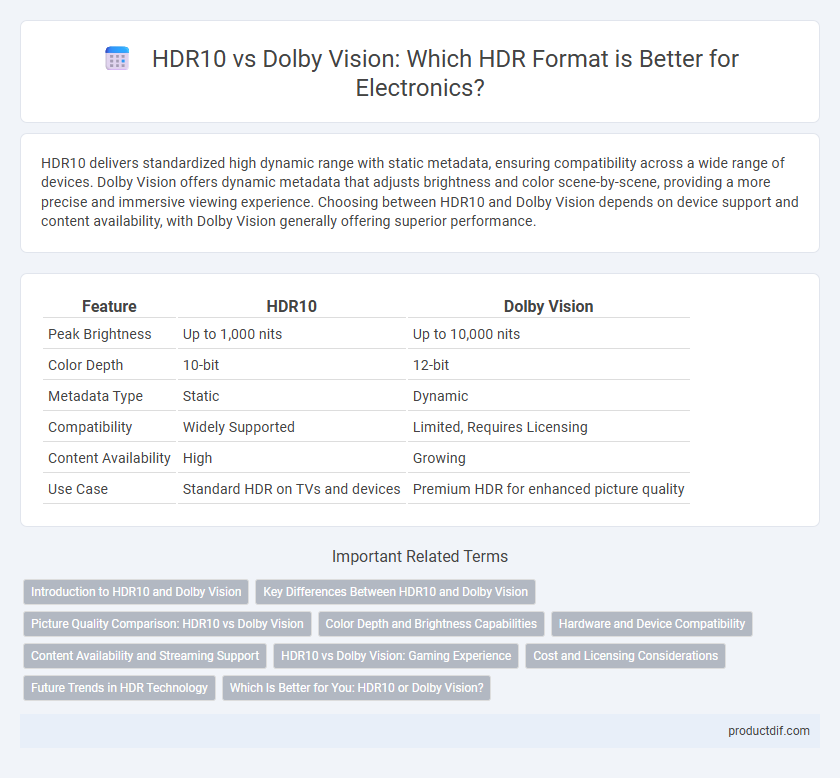HDR10 delivers standardized high dynamic range with static metadata, ensuring compatibility across a wide range of devices. Dolby Vision offers dynamic metadata that adjusts brightness and color scene-by-scene, providing a more precise and immersive viewing experience. Choosing between HDR10 and Dolby Vision depends on device support and content availability, with Dolby Vision generally offering superior performance.
Table of Comparison
| Feature | HDR10 | Dolby Vision |
|---|---|---|
| Peak Brightness | Up to 1,000 nits | Up to 10,000 nits |
| Color Depth | 10-bit | 12-bit |
| Metadata Type | Static | Dynamic |
| Compatibility | Widely Supported | Limited, Requires Licensing |
| Content Availability | High | Growing |
| Use Case | Standard HDR on TVs and devices | Premium HDR for enhanced picture quality |
Introduction to HDR10 and Dolby Vision
HDR10 is a widely adopted high dynamic range (HDR) standard that uses static metadata to enhance brightness, contrast, and color accuracy in displays. Dolby Vision, a proprietary HDR format, employs dynamic metadata to optimize each scene or frame, delivering superior picture quality with more precise color grading and brightness control. Both technologies significantly improve the viewing experience by expanding the range of luminance and color beyond standard dynamic range (SDR) content.
Key Differences Between HDR10 and Dolby Vision
HDR10 utilizes static metadata to apply a single tone-mapping curve throughout the entire content, while Dolby Vision uses dynamic metadata allowing scene-by-scene or frame-by-frame adjustments for more precise brightness and color accuracy. HDR10 supports up to 10-bit color depth and a peak brightness of 1,000 nits, whereas Dolby Vision can handle up to 12-bit color and peak brightness levels reaching 10,000 nits. Dolby Vision requires compatible hardware and licensing fees, making it less universally supported compared to the open standard HDR10, which is widely adopted across most displays and streaming services.
Picture Quality Comparison: HDR10 vs Dolby Vision
HDR10 offers a baseline dynamic range with static metadata, delivering consistent brightness and color accuracy across scenes. Dolby Vision enhances picture quality by utilizing dynamic metadata to adjust contrast and color on a per-frame basis, resulting in richer details and more vibrant visuals. This dynamic approach enables Dolby Vision to achieve superior brightness levels and deeper blacks, providing a more immersive viewing experience compared to HDR10.
Color Depth and Brightness Capabilities
HDR10 supports 10-bit color depth, providing over 1 billion colors, while Dolby Vision enhances this with up to 12-bit color depth, enabling over 68 billion colors for more precise and vibrant visuals. Dolby Vision also offers dynamic metadata that adjusts brightness on a scene-by-scene basis, reaching peak brightness levels of up to 10,000 nits compared to HDR10's static metadata and typical peak brightness around 1,000 nits. These advancements allow Dolby Vision to deliver superior color accuracy and enhanced contrast, significantly improving the overall viewing experience in compatible displays.
Hardware and Device Compatibility
HDR10 is widely supported across a broad range of devices, including most 4K TVs, monitors, and streaming devices, due to its open standard and lower hardware requirements. Dolby Vision demands compatible hardware with dynamic metadata processing capabilities, often found in premium TVs, Blu-ray players, and select streaming devices, ensuring enhanced image quality with scene-by-scene adjustments. Device compatibility with Dolby Vision typically requires licensed chipsets and firmware support, making it less universally available than HDR10 but delivering superior HDR performance when supported.
Content Availability and Streaming Support
HDR10 is widely supported across major streaming platforms such as Netflix, Amazon Prime Video, and Disney+, offering extensive content availability in HDR. Dolby Vision, while providing dynamic metadata for superior picture quality, has more limited but growing support on platforms like Apple TV+ and Netflix. Streaming devices and smart TVs increasingly support both HDR10 and Dolby Vision to cater to diverse content libraries and ensure optimal viewing experiences.
HDR10 vs Dolby Vision: Gaming Experience
HDR10 delivers a standardized gaming experience with broad compatibility across gaming consoles and displays, offering peak brightness up to 1,000 nits and 10-bit color depth. Dolby Vision enhances gameplay by dynamically adjusting brightness, contrast, and color on a scene-by-scene basis, providing up to 12-bit color depth and higher peak brightness levels, which results in more vivid visuals and deeper immersion. Gamers using Dolby Vision-enabled devices benefit from superior image accuracy and enhanced HDR performance, especially in titles supporting dynamic metadata.
Cost and Licensing Considerations
HDR10 is an open standard with no associated licensing fees, making it a cost-effective choice for manufacturers and consumers seeking affordable high dynamic range technology. Dolby Vision requires licensing fees and certification costs, which can increase production expenses and retail prices but offers advanced dynamic metadata for superior picture quality. The decision between HDR10 and Dolby Vision often depends on budget constraints and desired image performance in electronic display products.
Future Trends in HDR Technology
HDR10 and Dolby Vision remain the leading HDR formats competing in the evolving electronics landscape, with Dolby Vision gaining traction due to its dynamic metadata capabilities and support for 12-bit color depth. Future HDR technology trends emphasize enhanced color accuracy, increased brightness levels surpassing 4000 nits, and wider compatibility with emerging display technologies such as MicroLED and OLED. Industry players are investing heavily in AI-driven content optimization and real-time HDR mastering to deliver superior viewing experiences across streaming, gaming, and broadcast platforms.
Which Is Better for You: HDR10 or Dolby Vision?
HDR10 offers broad compatibility with most TVs, streaming devices, and gaming consoles, making it a cost-effective choice for standard HDR content. Dolby Vision provides dynamic metadata that adjusts settings scene-by-scene for superior brightness, contrast, and color accuracy, ideal for premium home theater setups. Choose HDR10 if budget and device compatibility are priorities, while Dolby Vision suits users seeking the highest visual quality and are equipped with compatible hardware.
HDR10 vs Dolby Vision Infographic

 productdif.com
productdif.com